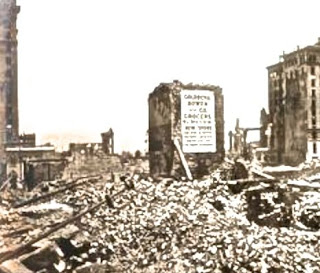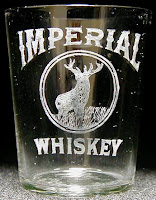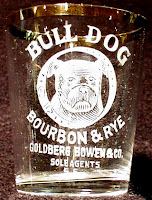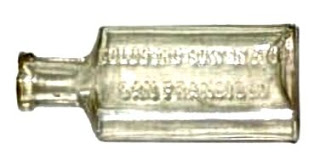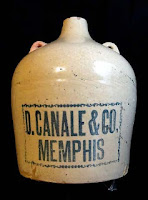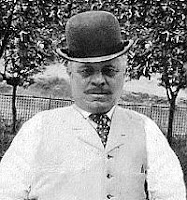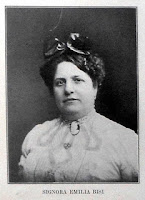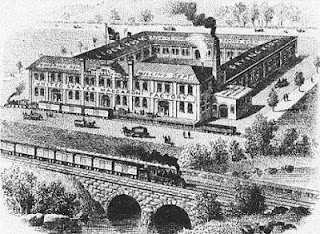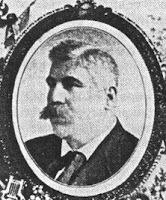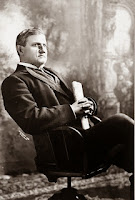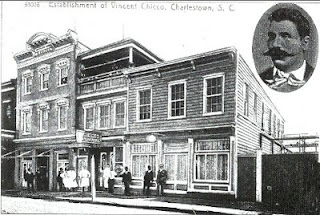Goldberg, Bowen Co.: From Ashes to “World Reach”
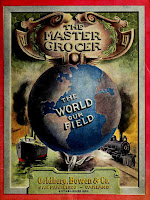 The sign left is brim full of confidence. Goldberg, Bowen & Company in 1915 were proclaiming the specialty grocery and liquor firm a “Master Grocer” with a “The World Our Field.” The claim was backed up by illustrations of goods delivered by ship and rail from all over the globe. Many San Franciscans, however, could remember when Goldberg, Bowen posted a quite different sign on the burned-out shell of its headquarters. During the early years of this business few would have predicted its ultimate success and longevity.
The sign left is brim full of confidence. Goldberg, Bowen & Company in 1915 were proclaiming the specialty grocery and liquor firm a “Master Grocer” with a “The World Our Field.” The claim was backed up by illustrations of goods delivered by ship and rail from all over the globe. Many San Franciscans, however, could remember when Goldberg, Bowen posted a quite different sign on the burned-out shell of its headquarters. During the early years of this business few would have predicted its ultimate success and longevity.
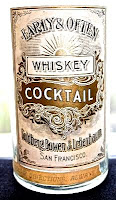 The company originated about 1881 with the merger of two established San Francisco firms. Bowen Brothers had started as fruit merchants but expanded into speciality groceries. Nearby, Lebenbaum & Goldberg were operating as liquor, wine and tea merchants. Consolidation created Goldberg, Bowen & Lebenbaum. The company was listed local business directories as “Importers of Wines and Liquors and Commercial and Retail Grocers.” As short-lived as this trio was destined to be, it early contracted with a German glass factory for a series of clear bottles topped by a logo, shown here.
The company originated about 1881 with the merger of two established San Francisco firms. Bowen Brothers had started as fruit merchants but expanded into speciality groceries. Nearby, Lebenbaum & Goldberg were operating as liquor, wine and tea merchants. Consolidation created Goldberg, Bowen & Lebenbaum. The company was listed local business directories as “Importers of Wines and Liquors and Commercial and Retail Grocers.” As short-lived as this trio was destined to be, it early contracted with a German glass factory for a series of clear bottles topped by a logo, shown here.
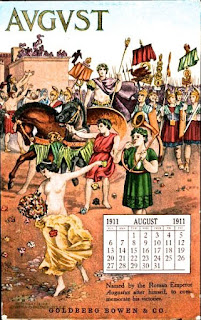 By 1885 Lebenbaum had left the organization, bought out by the Bowens, Charles and Henry. The new organization was renamed Goldberg, Bowen & Co. Running the enterprise was Jacob Goldberg, an immigrant from Poland, listed in directories as president and general manager. The company advertised in San Francisco “Blue Book” that their groceries “make food a pleasure worth while….” A writer for the San Francisco called the two company stores, located at 242-254 Sutter and 426-432 Pine Street “a paradise for the bon vivant.” A calendar caught the celebratory flavor of the company.
By 1885 Lebenbaum had left the organization, bought out by the Bowens, Charles and Henry. The new organization was renamed Goldberg, Bowen & Co. Running the enterprise was Jacob Goldberg, an immigrant from Poland, listed in directories as president and general manager. The company advertised in San Francisco “Blue Book” that their groceries “make food a pleasure worth while….” A writer for the San Francisco called the two company stores, located at 242-254 Sutter and 426-432 Pine Street “a paradise for the bon vivant.” A calendar caught the celebratory flavor of the company.
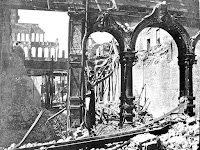 In 1906, this “paradise” became an inferno as the great San Francisco earthquake and fire of 1906 turned Goldberg, Bowen’s Sutter Street headquarters into a burned out shell amidst acres of rubble, as shown below. The disaster also was reduced to ruins the nearby stables where the partners kept the horses used to pull their wagons and delivery carts. I can find no information on the fate of the horses, although many in San Francisco are said to have been killed by falling bricks from the earthquake.
In 1906, this “paradise” became an inferno as the great San Francisco earthquake and fire of 1906 turned Goldberg, Bowen’s Sutter Street headquarters into a burned out shell amidst acres of rubble, as shown below. The disaster also was reduced to ruins the nearby stables where the partners kept the horses used to pull their wagons and delivery carts. I can find no information on the fate of the horses, although many in San Francisco are said to have been killed by falling bricks from the earthquake.
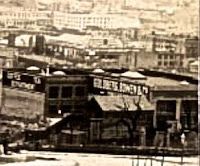 The sign visible on the side of the building made clear that despite the blow the disaster had leveled on them, the partners were determined to press on. It read: “Goldberg, Bowen and Co. Grocers Will Open a Grand New Store, Van Ness & Sutter. Present Location 2829 Cal. St., Cor. Haight & Masonic.” The second store, apparently untouched by the fire, is shown here, the name in large letters on the side.
The sign visible on the side of the building made clear that despite the blow the disaster had leveled on them, the partners were determined to press on. It read: “Goldberg, Bowen and Co. Grocers Will Open a Grand New Store, Van Ness & Sutter. Present Location 2829 Cal. St., Cor. Haight & Masonic.” The second store, apparently untouched by the fire, is shown here, the name in large letters on the side.
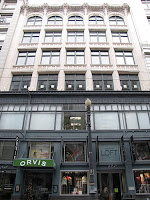 True to their pledge by 1909 Goldberg, Bowen was back in business at the old address, with a building, bigger and better than the one before. Shown here, it still stands at 242 Sutter. The company eventually would have four stores, including one in Oakland. Goldberg, Bowen was on its way to “World Reach.”
True to their pledge by 1909 Goldberg, Bowen was back in business at the old address, with a building, bigger and better than the one before. Shown here, it still stands at 242 Sutter. The company eventually would have four stores, including one in Oakland. Goldberg, Bowen was on its way to “World Reach.”
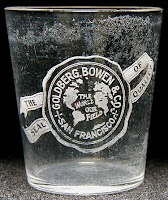 Goldberg, Bowen offered a full line of whiskeys, featuring imported Scotch brands, well-known American labels like “Old Crow” and an impressive number of proprietary “signature” brands. The partners were careful to register trademarks for most of their labels after the U.S. Congress progressively tightened the laws against brand infringement. Their whiskeys with dates of their registration were “Bull Dog Rye” (1906), “Old William Penn Malt” (1906), ”Early & Often Whiskey” (1908), “Pride of the Golden State” (1913),” Imperial Whiskey (1914), “Old Mellow Rye” (1914), and “Traveler Club(1915).”
Goldberg, Bowen offered a full line of whiskeys, featuring imported Scotch brands, well-known American labels like “Old Crow” and an impressive number of proprietary “signature” brands. The partners were careful to register trademarks for most of their labels after the U.S. Congress progressively tightened the laws against brand infringement. Their whiskeys with dates of their registration were “Bull Dog Rye” (1906), “Old William Penn Malt” (1906), ”Early & Often Whiskey” (1908), “Pride of the Golden State” (1913),” Imperial Whiskey (1914), “Old Mellow Rye” (1914), and “Traveler Club(1915).”

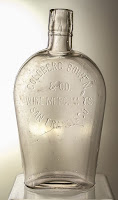 Goldberg, Bowen were not distillers. They were buying raw whiskey from distilleries elsewhere in America and shipping it into their headquarters. There they employed “rectifiers” who blended the products to achieve a particular taste, smoothness and color. The multitude of brands meant that their crew of blenders was highly skilled. The company apparently was not particular about the quality of bottles used. Shown here right is a clear flask, possibly a pint, that displays poorly blown glass. An amber quart is more presentable. The small bottle below was called a “Quiet Smile” flask; three of them filled with whiskey sold for 50 cents.
Goldberg, Bowen were not distillers. They were buying raw whiskey from distilleries elsewhere in America and shipping it into their headquarters. There they employed “rectifiers” who blended the products to achieve a particular taste, smoothness and color. The multitude of brands meant that their crew of blenders was highly skilled. The company apparently was not particular about the quality of bottles used. Shown here right is a clear flask, possibly a pint, that displays poorly blown glass. An amber quart is more presentable. The small bottle below was called a “Quiet Smile” flask; three of them filled with whiskey sold for 50 cents.
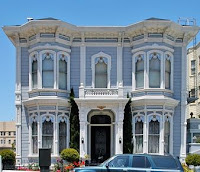 The profitability of the business was indicated in 1905 when Jacob Goldberg moved his wife, Kate, born in New York of Polish immigrants, and their five children, Sol, Harry, Cherney, Renne, and Zelda, into one of San Francisco’s most notable frame mansions at 1782 Pacific Avenue. Built in 1876, the house from the street appears to be two stories but because of the slope on which it was built, is three stories at the rear. Purchased by the Goldbergs in 1905, Jacob added a new wing, replaced the carriage house with a larger one, and remodeled the interior. Undamaged by the 1906 earthquake and fire, it was owned by the family until 1936. Today it is a San Francisco landmark.
The profitability of the business was indicated in 1905 when Jacob Goldberg moved his wife, Kate, born in New York of Polish immigrants, and their five children, Sol, Harry, Cherney, Renne, and Zelda, into one of San Francisco’s most notable frame mansions at 1782 Pacific Avenue. Built in 1876, the house from the street appears to be two stories but because of the slope on which it was built, is three stories at the rear. Purchased by the Goldbergs in 1905, Jacob added a new wing, replaced the carriage house with a larger one, and remodeled the interior. Undamaged by the 1906 earthquake and fire, it was owned by the family until 1936. Today it is a San Francisco landmark.
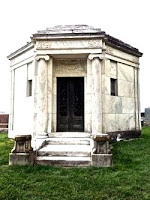 Jacob Goldberg lived just long enough to see National Prohibition imposed on the United States, dying in 1920 at the age of 76 or 77. He was buried in the family mausoleum in Cypress Lawn Memorial Park (Section F, lot 555) in Colma, California, just outside San Francisco. Other family members over time would join him there. Because of its trade in a variety of speciality groceries, Goldberg, Bowen successfully continued in business despite the loss of its liquor sales. With Repeal the company again sold alcoholic products. It shows up in San Francisco directories at least until 1974. Having survived the San Francisco earthquake and fire, National Prohibition was just another bump in the road to “World Reach.”
Jacob Goldberg lived just long enough to see National Prohibition imposed on the United States, dying in 1920 at the age of 76 or 77. He was buried in the family mausoleum in Cypress Lawn Memorial Park (Section F, lot 555) in Colma, California, just outside San Francisco. Other family members over time would join him there. Because of its trade in a variety of speciality groceries, Goldberg, Bowen successfully continued in business despite the loss of its liquor sales. With Repeal the company again sold alcoholic products. It shows up in San Francisco directories at least until 1974. Having survived the San Francisco earthquake and fire, National Prohibition was just another bump in the road to “World Reach.”
Note: This post was drawn from a variety of sources. Among them was the blog western whiskey.com and its post of December 1, 2009.

